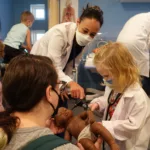Engaging Activities for Toddlers to Learn About Engineering Through Play
Do you have a little tinkerer at home? DIY Engineering activities help toddlers learn about the world around them through play. Children develop a positive relationship to learning, problem-solving, communication, and much more when they are having fun doing it!
At the Children’s Museum of Sonoma County, we encourage this balance of education and play by incorporating STEAM activities into children’s everyday routines!
What is STEAM Learning?
STEAM is an acronym that stands for Science, Technology, Engineering, Art, and Math. It is a fun and engaging educational pathway that encompasses these five essential areas of learning to best benefit early childhood development.
STEAM-based engineering activities encourage young minds to think critically, openly approach new situations, and develop a better understanding of how the world works.
STEAM Engineering Activities Help Toddlers and Children Learn About:
- Building
- Balance
- Functionality
- Creative design
- Measuring
- And much more!
STEAM Engineering Activities for Toddlers at Home
With these fun engineering activities, toddlers can gain a better understanding of how things fit together, what tasks require specific tools, creative ways to achieve their goals, and much more!
1. Build a Fort Out of Stuff from Around the House
Forts are magical fortresses and inspire much more than just throwing together a few couch cushions and blankets. When it comes to building a fort, kids are naturally learning new lifelong skills.
Letting your child take the lead on building is important because there is no wrong way to build a fort, but the skills they used to erect it are important to encourage at their age. If you supply the pillows, sheets, and any other common household item they could use to build with, you might be surprised at the outcome.
Creativity, problem-solving, resourcefulness, and curiosity will all naturally arise when building a fort. With this combination of creative imagination and ingenuity, the possibilities are endless.
2. Build Tinfoil People
Using everyday home goods, this project encourages kids to think about shapes in a three dimensional way. The tin foil starters off flat, but by following the directions in the video below, you can learn how to sculpt a 3D tinfoil person!
There are endless possibilities you can explore and create with tinfoil, but knowing how much you’ll need and how to handle it so it doesn’t tear can make some shapes more challenging. See what other figures or objects your toddler can sculpt!
3. Try the “Attach it Engineering Challenge”
The “Attach it Challenge” is a fun and creative way for kids to develop new engineering skills. The objective of the challenge is to attach two or more pieces of cardboard together without the use of glue, or tape.
- Tying – How many pieces of cardboard can you wrap string around to tie them together securely? Try using different sized pieces of cardboard and build up and out to see how many they can tie together.
- Stitching – Punch small holes along the edge of two or more pieces of cardboard and thread string through one hole on each piece of cardboard and stitch them together. This is also great practice for tying shoelaces!
- Slots – Cut a thin slot to the middle of two or more pieces of cardboard and slide them together. Try to create an ‘X’ shape, a ‘T’ shape, and eventually try to make a four sided box!
- Nailing – Use wooden golf tees to “nail” two pieced of cardboard together. You can even use a full cardboard box to nail pieces of cardboard to it too!
- Magnets – How many magnets does it take to hang a piece of cardboard on the fridge? Try cutting the cardboard into smaller sizes, and different shapes to see how that affects where to put the magnets and how many you need.
4. Build a Toddler Tool Box
By creating a Toddler Toolbox you can help your child expand their familiarity with how and when to use various devices to achieve different tasks. Take an old lunch box, or any other easy to carry container, and add some toddler-friendly tools they can use:
- Tape
- A pencil
- String
- Magnifying glass
- And anything else they may need!
As your toddler interacts with new tools, they start to develop a deeper understanding of when they are needed and how to accomplish different tasks with them. As they get older you can work together to add or replace new age-appropriate tools.
Explore More Fun STEAM Engineering Activities for Toddlers from CMOSC
The Children’s Museum of Sonoma County strives to continue to provide valuable resources to our community. Follow our YouTube channel for more engaging educational activities your children can enjoy at home!
You can also sign up for our newsletter to get regular updates and additional resources from the Children’s Museum. Our emails contain our latest At-Home Activities, educational resources, and fun videos for children of all ages.
Sign up for E-News!
Sign up for E-News Form








